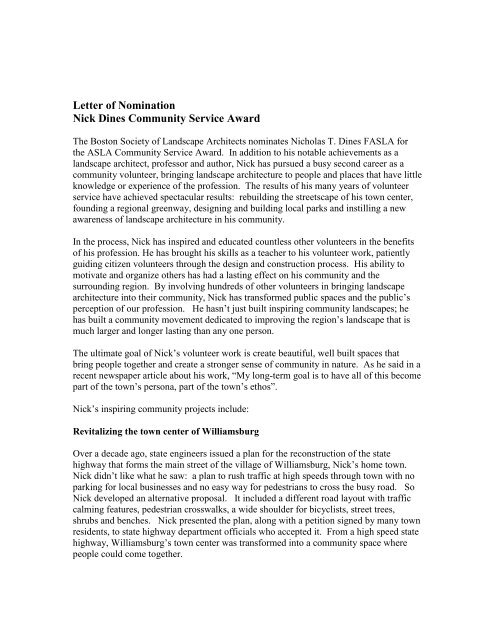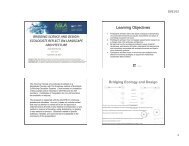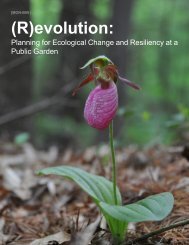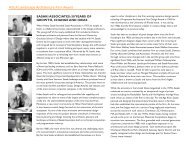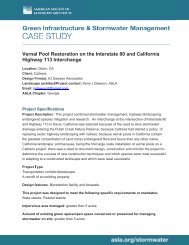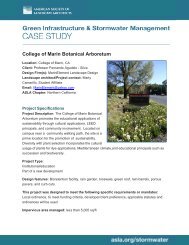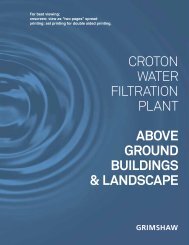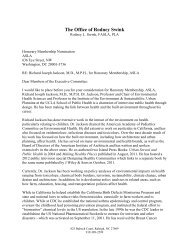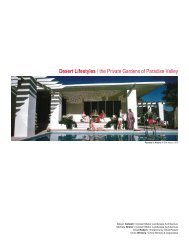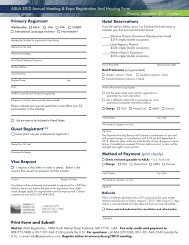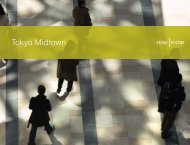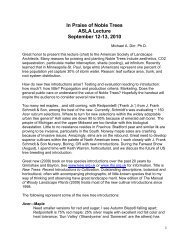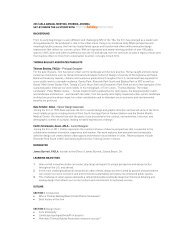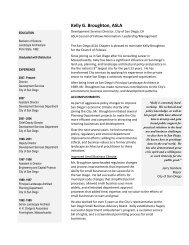Letter of Nomination Nick Dines Community Service Award
Letter of Nomination Nick Dines Community Service Award
Letter of Nomination Nick Dines Community Service Award
You also want an ePaper? Increase the reach of your titles
YUMPU automatically turns print PDFs into web optimized ePapers that Google loves.
<strong>Letter</strong> <strong>of</strong> <strong>Nomination</strong><br />
<strong>Nick</strong> <strong>Dines</strong> <strong>Community</strong> <strong>Service</strong> <strong>Award</strong><br />
The Boston Society <strong>of</strong> Landscape Architects nominates Nicholas T. <strong>Dines</strong> FASLA for<br />
the ASLA <strong>Community</strong> <strong>Service</strong> <strong>Award</strong>. In addition to his notable achievements as a<br />
landscape architect, pr<strong>of</strong>essor and author, <strong>Nick</strong> has pursued a busy second career as a<br />
community volunteer, bringing landscape architecture to people and places that have little<br />
knowledge or experience <strong>of</strong> the pr<strong>of</strong>ession. The results <strong>of</strong> his many years <strong>of</strong> volunteer<br />
service have achieved spectacular results: rebuilding the streetscape <strong>of</strong> his town center,<br />
founding a regional greenway, designing and building local parks and instilling a new<br />
awareness <strong>of</strong> landscape architecture in his community.<br />
In the process, <strong>Nick</strong> has inspired and educated countless other volunteers in the benefits<br />
<strong>of</strong> his pr<strong>of</strong>ession. He has brought his skills as a teacher to his volunteer work, patiently<br />
guiding citizen volunteers through the design and construction process. His ability to<br />
motivate and organize others has had a lasting effect on his community and the<br />
surrounding region. By involving hundreds <strong>of</strong> other volunteers in bringing landscape<br />
architecture into their community, <strong>Nick</strong> has transformed public spaces and the public’s<br />
perception <strong>of</strong> our pr<strong>of</strong>ession. He hasn’t just built inspiring community landscapes; he<br />
has built a community movement dedicated to improving the region’s landscape that is<br />
much larger and longer lasting than any one person.<br />
The ultimate goal <strong>of</strong> <strong>Nick</strong>’s volunteer work is create beautiful, well built spaces that<br />
bring people together and create a stronger sense <strong>of</strong> community in nature. As he said in a<br />
recent newspaper article about his work, “My long-term goal is to have all <strong>of</strong> this become<br />
part <strong>of</strong> the town’s persona, part <strong>of</strong> the town’s ethos”.<br />
<strong>Nick</strong>’s inspiring community projects include:<br />
Revitalizing the town center <strong>of</strong> Williamsburg<br />
Over a decade ago, state engineers issued a plan for the reconstruction <strong>of</strong> the state<br />
highway that forms the main street <strong>of</strong> the village <strong>of</strong> Williamsburg, <strong>Nick</strong>’s home town.<br />
<strong>Nick</strong> didn’t like what he saw: a plan to rush traffic at high speeds through town with no<br />
parking for local businesses and no easy way for pedestrians to cross the busy road. So<br />
<strong>Nick</strong> developed an alternative proposal. It included a different road layout with traffic<br />
calming features, pedestrian crosswalks, a wide shoulder for bicyclists, street trees,<br />
shrubs and benches. <strong>Nick</strong> presented the plan, along with a petition signed by many town<br />
residents, to state highway department <strong>of</strong>ficials who accepted it. From a high speed state<br />
highway, Williamsburg’s town center was transformed into a community space where<br />
people could come together.
<strong>Nick</strong> <strong>Dines</strong> <strong>Nomination</strong> <strong>Letter</strong><br />
Page 2 <strong>of</strong> 5<br />
After gaining the support from local <strong>of</strong>ficials and key community organizations and<br />
leaders, <strong>Nick</strong> began an energetic fundraising campaign to gather financial support from<br />
local residents and businesses. A key participant in this process, the manager <strong>of</strong> the<br />
Williamsburg branch <strong>of</strong> Florence Savings Bank, observed that <strong>Nick</strong> does a lot <strong>of</strong> things<br />
behind the scenes to make his volunteer projects a success. As a result, limited public<br />
funds were supplemented by generous private donations <strong>of</strong> money, materials and labor<br />
from local stores, contractors, banks and restaurants.<br />
<strong>Nick</strong>’s project didn’t just involve planting flowers on Main Street. It was one <strong>of</strong> the first<br />
applications <strong>of</strong> traffic calming and complete streets in the region, leading to a<br />
fundamentally new, more balanced relationship between cars and pedestrians. It has<br />
since helped lead to a change in the mentality <strong>of</strong> the state highway department which has<br />
recently embraced complete streets as <strong>of</strong>ficial policy. The successful Williamsburg<br />
project helped make this fundamental policy change possible. Likewise at the town<br />
level, local engineering, public works and town leaders and businesses who were initially<br />
skeptical <strong>of</strong> these new concepts have been won over by <strong>Nick</strong>’s powers <strong>of</strong> persuasion and<br />
the success <strong>of</strong> his built work.<br />
While the project’s policy implications are important, it’s also important to point out that<br />
<strong>Nick</strong> is <strong>of</strong>ten seen planting, watering or weeding his Main Street flower beds in the<br />
summertime. He has planted over 800’ <strong>of</strong> the streetscape with shade trees, shrubs and an<br />
array <strong>of</strong> flowering shrubs that bloom from early spring through late fall. <strong>Nick</strong>’s<br />
landscape craftsmanship, design skill and construction savvy (he taught construction at<br />
UMass and Harvard for over three decades) have brought greenery and blooms to a<br />
former asphalt landscape.<br />
Mill River Greenway Initiative<br />
The Mill River flows from the steep, wooded hills <strong>of</strong> western Massachusetts down to the<br />
flat, fertile valley <strong>of</strong> the Connecticut River in Northampton. True to its name, the Mill<br />
River became a vital source <strong>of</strong> power for dozens <strong>of</strong> small manufactories during the early<br />
industrial revolution making everything from lumber to silk to brass buttons. These<br />
small mills and the towns they supported shaped the character and economy <strong>of</strong> the<br />
watershed. Today the mills are gone but the remains <strong>of</strong> the dams, buildings and power<br />
canals still exist, testaments to a bygone age that still shapes the region.<br />
Realizing the need to preserve this cultural and natural heritage, <strong>Nick</strong> helped found the<br />
Mill River Greenway Initiative in 2009. Consisting <strong>of</strong> representatives from the towns<br />
and cities in the watershed, local businesses, environmentalists and community leaders,<br />
the Initiative’s goal is to preserve and enhance the natural and cultural character <strong>of</strong> the<br />
watershed. In tackling this regional challenge, <strong>Nick</strong> has used the same approach he has<br />
so successfully brought to bear on his volunteer site design projects. He has seen the
<strong>Nick</strong> <strong>Dines</strong> <strong>Nomination</strong> <strong>Letter</strong><br />
Page 3 <strong>of</strong> 5<br />
problem first, taken the initiative before anyone else has stepped forward, used his<br />
powers <strong>of</strong> persuasion and inspiration and refused to give up when things get frustrating.<br />
As a result, the Greenway Initiative was up and running within six months and has<br />
achieved remarkable results in the three short years <strong>of</strong> its existence. It has attracted a<br />
dynamic and highly qualified board and a large brigade <strong>of</strong> citizen and pr<strong>of</strong>essional<br />
volunteers. It has proposed a number <strong>of</strong> specific projects in key areas <strong>of</strong> the watershed<br />
including resurrecting a branch <strong>of</strong> the river in the City <strong>of</strong> Northampton, building a<br />
cantilevered walkway from Haydenville to Williamsburg and creating a trail interpreting<br />
the Great Flood <strong>of</strong> 1874. Thanks to <strong>Nick</strong>’s skills as a publicist, the Greenway Initiative<br />
has received widespread press coverage for these efforts as well as testimonials <strong>of</strong><br />
support from local <strong>of</strong>ficials and businesses.<br />
<strong>Nick</strong>’s work on the Greenway Initiative shows the breadth <strong>of</strong> his skills as a community<br />
volunteer ranging from the planting <strong>of</strong> flower gardens along his Main Street to the<br />
stewardship <strong>of</strong> a 52 square mile watershed linking rural forests to thriving cities. As<br />
such, his volunteer work reflects the breadth and depth <strong>of</strong> the pr<strong>of</strong>ession <strong>of</strong> landscape<br />
architecture and the remarkable range <strong>of</strong> project scales and civic purpose achieved by<br />
Frederick Law Olmsted.<br />
Mill River Trail and Parks<br />
As part <strong>of</strong> the Mill River Greenway project, <strong>Nick</strong> has completed the planning and<br />
preliminary design and permitting for a proposed trail and sidewalk lining the Mill River<br />
from Williamsburg to Haydenville. He is developing a detailed, site specific schematic<br />
design plan for the trail and working with local communities, residents and abutters to<br />
create the plans. The site <strong>of</strong> the trail is <strong>of</strong>ten squeezed between Route 9 - a busy state<br />
highway – and the banks <strong>of</strong> the Mill River which are at times lined with a high concrete<br />
retaining wall. <strong>Nick</strong>’s experience in landscape construction is proving essential in<br />
developing a plan that meets these challenging safety and construction constraints. As<br />
usual, he is enlisting widespread support and volunteer participation in this project.<br />
Meekins Park<br />
<strong>Nick</strong> was the leader <strong>of</strong> a successful effort to transform a neglected corner <strong>of</strong> the Mill<br />
River Greenway into new park adjacent to the town <strong>of</strong> Williamsburg’s library. The goal<br />
<strong>of</strong> the project was to make the Mill River more visible and accessible to the public, a first<br />
step in his vision for a restoration <strong>of</strong> the river in Williamsburg. In fact, the construction<br />
<strong>of</strong> Meekins park is one <strong>of</strong> the first accomplishments <strong>of</strong> the Mill River Watershed<br />
Initiative, a watershed-wide effort that <strong>Nick</strong> helped found whose goal is to make the river<br />
more accessible, scenic and cleaner.
<strong>Nick</strong> <strong>Dines</strong> <strong>Nomination</strong> <strong>Letter</strong><br />
Page 4 <strong>of</strong> 5<br />
Meekins Park is designed to accommodate public access to the Mill River’s edge while<br />
providing a safe barrier in the form <strong>of</strong> a restored iron fence. The new space is intended to<br />
serve Library functions and other public events. New benches will allow users to sit next<br />
to the river and view both upstream and downstream while reading or accessing the<br />
Library’s wireless Internet connection and perhaps one day, taking a virtual tour <strong>of</strong> the<br />
new Mill River Greenway. The new park may serve as a lunchtime respite, a place for<br />
seasonal events (Arts and Crafts shows, Farmer’s Market, Fall Festival, etc.), or merely<br />
as a place to gaze at the ever-changing qualities <strong>of</strong> the Mill River as it passes through<br />
Williamsburg on its way to Northampton and onto the Connecticut River.<br />
While the project looks simple, which adds to its beauty, the process required to seek<br />
permits and work on riparian buffers was complicated. <strong>Nick</strong> designed and built Meekins<br />
Park with the help <strong>of</strong> numerous local citizen volunteers. <strong>Nick</strong> also recruited local<br />
businesses to donate their time, materials and expertise including contractors, the<br />
Williamsburg Highway Department and a local stone quarry, who donated 60′ <strong>of</strong> cap<br />
stones and wall stones, as well as patio stones for the sitting terrace. The project was<br />
funded in part by Town Meeting appropriation, private donations, and the Friends <strong>of</strong> the<br />
Meekins Library. It took a “Village” for the Park to become a reality.<br />
A stone terrace was constructed to commemorate the site <strong>of</strong> an old dam (long removed),<br />
and provides three benches at two different levels that allow users to look up and down<br />
the Mill River while sitting next to the fence. The new lawn area is the location <strong>of</strong> a new<br />
Farmer’s Market starting last summer which features local produce and wares.<br />
Other Volunteer Work<br />
Angel Park: <strong>Nick</strong> designed and built a small park in Williamsburg called Angel Park.<br />
This small park near the center <strong>of</strong> town was established as a memorial and place <strong>of</strong><br />
reflection and was built with private donations. <strong>Nick</strong> led a group <strong>of</strong> volunteers in<br />
building the brick walkways, retaining walls, a tool storage shed and the installation <strong>of</strong><br />
plants. The park is now the site <strong>of</strong> a summer concert series each year.<br />
Baystate Franklin Medical Center Garden and Courtyard: <strong>Nick</strong> has begun design work<br />
on a contemplative garden in a courtyard <strong>of</strong> the Franklin Medical Center, a regional<br />
hospital in nearby Greenfield. The garden will feature shrubs, groundcovers and a wide<br />
variety <strong>of</strong> flowers as well as seating and a small plaza for the use and enjoyment <strong>of</strong><br />
patients and visitors to the hospital.<br />
Williamsburg Arts Council: Chairman and Member, Williamsburg Arts Council,<br />
Williamsburg, Massachusetts, 1983-1987. <strong>Nick</strong>’s work included organizing the<br />
activities <strong>of</strong> the council, fundraising, recruiting volunteers, organizing special events and<br />
promoting landscape architecture as an art form.
<strong>Nick</strong> <strong>Dines</strong> <strong>Nomination</strong> <strong>Letter</strong><br />
Page 5 <strong>of</strong> 5<br />
Academic: Member, College Personnel Committee, College <strong>of</strong> Food and Natural<br />
Resources, 1992-2003; Editorial Advisor, Science and Technology Group <strong>of</strong> the<br />
McGraw Hill Book Company, 1987-Present; Editorial Board Member and Co-Founder,<br />
"New England Landscapes", 1987-Present; Member, Committee on International<br />
Research, College <strong>of</strong> Food and Natural Resources, 1987-1988; Member, Campus<br />
Planning Committee, University <strong>of</strong> Massachusetts, Amherst 1994-2003; Design and<br />
Construction <strong>of</strong> the Waugh Memorial Garden, University <strong>of</strong> Massachusetts, 1986-1987;<br />
Advisor, University Arts Council, University <strong>of</strong> Massachusetts Amherst; Consultant to<br />
U.S. Department <strong>of</strong> Energy, 1985; Faculty Senator, University <strong>of</strong> Massachusetts,<br />
Amherst, Massachusetts, 1973-1976<br />
ASLA: Chairman, Open Committee on Energy, 1982-1987; Acting BSLA Program<br />
Director, 1990-1991; Chairman, Accreditation Team, 1989-Present <br />
<strong>Nick</strong> Dine’s leadership as a volunteer has transformed physical spaces as well as attitudes<br />
in his community and the greater region. He has brought a new awareness <strong>of</strong> the<br />
benefits and potential <strong>of</strong> landscape architecture to thousands <strong>of</strong> people through his ability<br />
to work with others, solve complex political and physical challenges and design beautiful<br />
and well built public landscapes created by volunteers. We heartily recommend <strong>Nick</strong> for<br />
the ASLA <strong>Community</strong> <strong>Service</strong> <strong>Award</strong>.<br />
Sincerely<br />
Kathleen Ogden<br />
President, Boston Chapter ASLA
Dear ASLA Jury,<br />
Travel through Williamsburg, Massachusetts during the spring, summer or fall and you<br />
will certainly notice the pr<strong>of</strong>usion <strong>of</strong> flowers blooming along Route 9 in the center <strong>of</strong><br />
town. Stop and stroll around town and you may read a book on the library patio, seek a<br />
quiet moment in Angel Park, read the names <strong>of</strong> veterans while relaxing in front <strong>of</strong> the<br />
Veteran’s Memorial, or sit next to the Mill River. The concept and creation <strong>of</strong> these<br />
public spaces in Williamsburg are largely the result <strong>of</strong> the dedication and energy <strong>of</strong> one<br />
person: Nicholas <strong>Dines</strong>.<br />
We would like to heartily endorse <strong>Nick</strong>’s nomination for the 2013 ASLA <strong>Community</strong><br />
<strong>Service</strong> <strong>Award</strong>. What makes <strong>Nick</strong> special and worthy <strong>of</strong> an ASLA <strong>Community</strong> <strong>Service</strong><br />
<strong>Award</strong> is his ability to use his technical knowledge and practical experience to create<br />
significant public spaces and beautify large areas <strong>of</strong> town that are enjoyed by all members<br />
<strong>of</strong> the community. Projects he has completed over the past several decades include:<br />
<strong>Nick</strong> designed the grounds surrounding the new addition to the Meekins Library<br />
and then led a group <strong>of</strong> volunteers to construct the plan. Funding for some <strong>of</strong> the<br />
materials was provided by the Town; other materials and time were donated by<br />
local businesses and citizens. This major project included a patio, several<br />
retaining walls and a set <strong>of</strong> stairs made <strong>of</strong> Goshen stone, and the installation <strong>of</strong><br />
many plantings. Later he led a second group in installing a wrought iron fence on<br />
top <strong>of</strong> the floodwall along the Mill River next to the library. <strong>Nick</strong>’s vision is to<br />
make the Mill River more visible and accessible to the public and the fence and<br />
sitting terrace were the first section <strong>of</strong> a planned river park in Williamsburg. <strong>Nick</strong><br />
continues to maintain the plantings around the library as a public service to the<br />
Town, and a new weekly farmers’ market is being planned for the lawn<br />
overlooking the river this spring and summer.<br />
Working with the Massachusetts Department <strong>of</strong> Transportation, <strong>Nick</strong> designed the<br />
main roadway intersection in Williamsburg. The State’s original plan was a<br />
barren expanse <strong>of</strong> asphalt and concrete without any parking for the local<br />
businesses or anywhere for people to stop, talk, or do anything else but sprint out<br />
<strong>of</strong> the way <strong>of</strong> traffic. His design calmed traffic, allowed cars to enter and exit two<br />
adjacent businesses and created a public space large enough for several trees and<br />
some shrubs. People are able to sit under the shade <strong>of</strong> the trees and safely navigate<br />
the intersection.<br />
N. <strong>Dines</strong> ASLA <strong>Community</strong> <strong>Service</strong> <strong>Award</strong> <strong>Letter</strong> <strong>of</strong> Support<br />
Page 1
<strong>Nick</strong> established and planted about 800 feet <strong>of</strong> flower beds along Route 9 in the<br />
central part <strong>of</strong> Williamsburg. He maintains the flower beds through his own<br />
efforts and with the help <strong>of</strong> volunteers under his direction. <strong>Nick</strong> obtains money for<br />
landscape supplies from local business donations and from proceeds from<br />
beverage container deposits donated at the town transfer station.<br />
He designed, organized materials and labor, and carried out the repair <strong>of</strong> the<br />
Veteran’s Memorial. This included masonry work on the memorial, installation <strong>of</strong><br />
a large terrace in front <strong>of</strong> the memorial and landscaping the Memorial with<br />
flowers, shrubs and trees.<br />
<strong>Nick</strong> helped design and build Angel Park. This small park near the school in the<br />
center <strong>of</strong> town was established as a memorial and place <strong>of</strong> reflection and funded<br />
with private donations. Through his enthusiasm and strong belief in what he is<br />
doing, <strong>Nick</strong> led a small group <strong>of</strong> volunteers in laying the brick walkways,<br />
building retaining walls and a tool storage shed, and installing the plants. The<br />
park is now the site for a summer concert series each year.<br />
<strong>Nick</strong>’s efforts to beautify the town are contagious. His work has inspired other businesses<br />
and private property owners to spruce up their own road front areas with landscaping and<br />
flowers. In effect, <strong>Nick</strong> has “set the standard” for landscape design and that standard is <strong>of</strong><br />
the highest quality.<br />
What makes <strong>Nick</strong> so much more than just an indefatigable gardener and beautifier <strong>of</strong> his<br />
surroundings is the fact that he does it all for a larger purpose that he is happy to<br />
articulate: he means to transform the civic life <strong>of</strong> the town for the better by creating<br />
settings where people can meet, converse, share activities, relax, bounce ideas around,<br />
participate as individuals in maintaining the town's public face, and feel comfortably at<br />
home in our public spaces. Because he uniquely combines that big vision with a great<br />
deal <strong>of</strong> practical know how, political acumen, physical stamina, patience and<br />
discriminating workmanship, he is succeeding brilliantly. We are a richer town, not just a<br />
prettier one, because <strong>of</strong> <strong>Nick</strong>.<br />
We thank the ASLA for their consideration <strong>of</strong> <strong>Nick</strong> <strong>Dines</strong> for the 2013 <strong>Community</strong><br />
<strong>Service</strong> <strong>Award</strong>.<br />
Sincerely,<br />
Lisa Wenner<br />
Director Meekins Library<br />
N. <strong>Dines</strong> ASLA <strong>Community</strong> <strong>Service</strong> <strong>Award</strong> <strong>Letter</strong> <strong>of</strong> Support<br />
Page 2
Boston Society <strong>of</strong> Landscape Architects<br />
19 Harrison St.<br />
Framingham, MA 01702<br />
Re: <strong>Letter</strong> <strong>of</strong> Support for <strong>Nick</strong> <strong>Dines</strong><br />
To Whom It May Concern:<br />
I am writing in support <strong>of</strong> the nomination <strong>of</strong> <strong>Nick</strong> <strong>Dines</strong> for the ASLA<br />
<strong>Community</strong> <strong>Service</strong> <strong>Award</strong>. I have known <strong>Nick</strong> for many years as a highly skilled<br />
teacher and practitioner, but only in the past three have I had the pleasure and honor <strong>of</strong><br />
working with him as a community collaborator.<br />
In 2009, a dozen local residents, including <strong>Nick</strong>, decided that the time was ripe to<br />
initiate a greenway program for our local Mill River, the main stem <strong>of</strong> which runs<br />
through the towns <strong>of</strong> Williamsburg and Northampton, Massachusetts. The Mill is a small<br />
river, 18 miles long with a 52 square mile watershed, but with an extraordinary industrial<br />
history dating back to the mid-17 th century. The river marks the central meeting place,<br />
and is the most important historical and natural feature <strong>of</strong> Williamsburg, the town in<br />
which <strong>Nick</strong> lives.<br />
Within six months we had formed the Mill River Greenway Initiative<br />
(http://millrivergreenway.org). <strong>Nick</strong> was the principle voice for the town <strong>of</strong><br />
Williamsburg and became our best conceptual thinker, developing a framework within<br />
which we continue to work and a simple explanation <strong>of</strong> what we do – the “elevator<br />
description” <strong>of</strong> the Initiative. It didn’t take long for me to figure out that <strong>Nick</strong> was a vital<br />
voice in his community, but it wasn’t his status as a teacher or designer, but rather as a<br />
doer. His revitalization <strong>of</strong> the town center around the Meekins Library convinced his<br />
fellow residents that he was dedicated to the town with a trusted voice and willing hands.<br />
I particularly remember a bike ride through Williamsburg, crossing the bridge in<br />
town, glancing to my right, and there was <strong>Nick</strong> and his fellow workers, setting rocks into<br />
the new wall that shored up the banks <strong>of</strong> the Mill. A year later, that pretty little park<br />
became the site <strong>of</strong> the Williamsburg farm market, the first open market anyone in town
could remember, now a location where the whole town meets on Thursdays from May to<br />
October. We immediately put the project on our website as a sample <strong>of</strong> what great<br />
design can do for the Mill River (http://millrivergreenway.org/?page_id=124)<br />
Working with a BSLA charrette in spring <strong>of</strong> 2012, <strong>Nick</strong> contributed a plan to link<br />
two Williamsburg villages together by way <strong>of</strong> a path that he designed. His ideas helped<br />
lead directly to the creation <strong>of</strong> an <strong>of</strong>ficial Williamsburg town Mill River Greenway<br />
Committee to develop alternatives to create such a path since it’s extremely difficult to<br />
navigate the only route except by car on a busy state road. <strong>Nick</strong>, <strong>of</strong> course, is on that<br />
committee, and we eagerly await the results <strong>of</strong> their work in March 2013.<br />
Whenever I ask local residents about the Mill River in Williamsburg, they<br />
inevitably refer me to <strong>Nick</strong>. He’s such a treasure to the town and to our region that we<br />
would never have been able to attain any <strong>of</strong> our success without his help and wise words.<br />
What an extraordinary impact he’s made, and what great success we’ve seen from his<br />
efforts!<br />
It’s an honor and pleasure to recommend him for the ASLA <strong>Community</strong> <strong>Service</strong><br />
<strong>Award</strong>.<br />
Sincerely,<br />
John Sinton<br />
Co-moderator Mill River Greenway Initiative<br />
Vice-chair Connecticut River Watershed Council Board <strong>of</strong> Trustees<br />
Adjunct Pr<strong>of</strong>essor <strong>of</strong> Landscape Architecture, Univ. <strong>of</strong> Massachusetts, Amherst
ASLA <strong>Community</strong> <strong>Service</strong> <strong>Award</strong> <strong>Nomination</strong>s<br />
636 Eye Street, NW<br />
Washington, DC 20001-3736<br />
Dear <strong>Community</strong> <strong>Service</strong> <strong>Award</strong> Jury:<br />
Town <strong>of</strong> Williamsburg<br />
Board <strong>of</strong> Selectmen<br />
141 Main Street, P.O. Box 447<br />
Haydenville, Massachusetts 01039-0447<br />
The Williamsburg Select Board highly recommends <strong>Nick</strong> <strong>Dines</strong> for the 2013 ASLA <strong>Community</strong><br />
<strong>Service</strong> <strong>Award</strong>. <strong>Nick</strong> has been an outstanding local volunteer for decades, bringing dramatic and<br />
positive change to the environment, character and sense <strong>of</strong> community <strong>of</strong> our town.<br />
<strong>Nick</strong>’s volunteer work has occurred at a variety <strong>of</strong> levels, ranging from new roadside plantings,<br />
to the creation <strong>of</strong> community parks to work with the larger watershed <strong>of</strong> the Mill River which<br />
flows through the center <strong>of</strong> our town. Regardless <strong>of</strong> the scale <strong>of</strong> his work, <strong>Nick</strong> brings<br />
tremendous energy, attention to detail, hard work and a unique ability to inspire, organize and<br />
lead other volunteers. His knowledge and enthusiasm for his work is infectious and results in the<br />
participation <strong>of</strong> large numbers <strong>of</strong> people in projects that develop town-wide support. As a result,<br />
<strong>Nick</strong> has changed the attitude <strong>of</strong> the town toward its public spaces, natural features and<br />
community gathering places.<br />
As leaders <strong>of</strong> the town’s government, we have been impressed by <strong>Nick</strong>’s ability to work with<br />
local, regional and state <strong>of</strong>ficials on a variety <strong>of</strong> projects. He has worked well with our board<br />
and other town boards, consulting with us on his ideas at early stages in the process and<br />
responding to our questions and concerns. We have played a central role in approving and<br />
supporting his proposals and have seen our ideas and recommendations become part <strong>of</strong> the final<br />
projects.<br />
<strong>Nick</strong> has also worked closely with large state agencies such as the state highway department who<br />
initially proposed creating a wide, high-speed highway through the center <strong>of</strong> our downtown.<br />
<strong>Nick</strong>’s ability to reason with state <strong>of</strong>ficials, develop realistic alternative plans and persevere with<br />
his proposals eventually convinced the state highway department to alter their road plans. The<br />
end result is a friendly, walkable downtown environment with increased parking for local<br />
businesses and more room for pedestrians, green space and ornamental plantings.<br />
New parks created at the Meekins Library and at Angel Park have enhanced the character <strong>of</strong> the<br />
village center. Again, <strong>Nick</strong> organized large numbers <strong>of</strong> volunteers to help conceive, design and<br />
build these new amenities. In the end, the volunteers and the town as a whole adopted these<br />
projects as their own, attesting to <strong>Nick</strong>’s skill as a motivator, educator and volunteer.<br />
___________________________________________________________________________________<br />
(413) 268-8400 selectmen@burgy.org Fax (413) 268-8409
ASLA <strong>Community</strong> <strong>Service</strong> <strong>Award</strong> <strong>Nomination</strong>s<br />
636 Eye Street, NW<br />
Washington, DC 20001-3736<br />
Page 2<br />
<strong>Nick</strong> has helped our town understand landscape architecture and the beauty, environmental<br />
health and strong sense <strong>of</strong> community the field can bring to communities large and small.<br />
<strong>Nick</strong>’s experience and enthusiasm for landscape architecture is infectious and has taught<br />
hundreds about how the pr<strong>of</strong>ession can directly benefit people’s lives. His mission has been to<br />
improve his town and to create a new awareness <strong>of</strong> our environment, our history, our community<br />
and the existing and potential beauty <strong>of</strong> our town for generations to come.<br />
For all these reasons, we encourage you to grant <strong>Nick</strong> the ASLA <strong>Community</strong> <strong>Service</strong> <strong>Award</strong> for<br />
2013.<br />
Sincerely,<br />
Denise L. Banister<br />
Clerk, Williamsburg Select Board<br />
___________________________________________________________________________________<br />
(413) 268-8400 selectmen@burgy.org Fax (413) 268-8409
UNIVERSITY OF MASSACHUSETTS Department <strong>of</strong> Landscape Architecture<br />
AMHERST and Regional Planning<br />
109 Hills North<br />
111 Thatcher Road, Ofc 1 voice: 413.545.2255<br />
Amherst, MA 01003-9357 fax: 413.545.1772<br />
To: ASLA <strong>Award</strong>s Committee<br />
From: Mark Lindhult, FASLA, Pr<strong>of</strong>essor<br />
Re: <strong>Nomination</strong> for <strong>Nick</strong> <strong>Dines</strong>, FASLA for the 2013 ASLA <strong>Community</strong> <strong>Service</strong> <strong>Award</strong><br />
I am writing to strongly support the nomination <strong>of</strong> Pr<strong>of</strong>essor Emeritus <strong>Nick</strong> <strong>Dines</strong>, FASLA<br />
for the 2013 ASLA <strong>Community</strong> <strong>Service</strong> <strong>Award</strong>. <strong>Nick</strong> was a faculty member at the<br />
University <strong>of</strong> Massachusetts for 35 years (1969-2004) and I had the honor and pleasure to<br />
share 21 <strong>of</strong> those years with him as a colleague.<br />
<strong>Nick</strong> is a true renaissance man – a designer, musician, poet, gardener, stone mason and award<br />
winning author (Time Saver Standards for Landscape Architecture, McGraw-Hill, 1997). He<br />
is driven by a deep intellectual curiosity that propelled him through his academic career and<br />
made him such a thoughtful educator. Generations <strong>of</strong> students benefited from his insights<br />
into the pr<strong>of</strong>ession. He has always believed that the landscape architect’s primary<br />
responsibility is to the public and he has been an advocate for public outreach his entire<br />
career.<br />
While at UMass <strong>Nick</strong> ran numerous design studios that provided direct outreach to<br />
communities in Massachusetts as well as chairing numerous masters projects that benefited<br />
public agencies and non-pr<strong>of</strong>it organizations. <strong>Nick</strong> engaged these public activities with a<br />
passion that he infused in his students, many <strong>of</strong> whom have gone on to be leaders in the<br />
pr<strong>of</strong>ession and in public agencies.<br />
What distinguishes <strong>Nick</strong> most is the community service that he has continued to perform<br />
during his retirement. He strongly believes that people will start to understand landscape<br />
architecture when they see it in their own front yard – mainly the public spaces that they<br />
engage with every day. For this reason, <strong>Nick</strong> took on his own local community <strong>of</strong><br />
Williamsburg, MA as a case study.<br />
When the Massachusetts Department <strong>of</strong> Transportation highway division decided that<br />
downtown Williamsburg needed a new intersection designed for “safety” (code for widening)<br />
<strong>Nick</strong> went to work realizing that the proposal would destroy the historic beauty <strong>of</strong> the<br />
downtown. He designed an alternative to the Mass DOT proposal that achieved their safety<br />
objectives, yet created rich planting areas and beds for flowers adjacent to businesses. He<br />
worked closely with the business owners and explained to the community how they could<br />
enrich their downtown. <strong>Nick</strong>’s design was accepted and constructed. To follow through on<br />
his commitment, he also did much <strong>of</strong> the planting installation and maintenance, some <strong>of</strong><br />
which has now been taken up by many <strong>of</strong> the local businesses. However, every spring <strong>Nick</strong><br />
can be seen in downtown Williamsburg tending to the lush plantings. He planted the seed<br />
and it has taken root.<br />
At a larger scale, <strong>Nick</strong> has taken an active role in the planning for the Mill River Greenway<br />
which became the WMass Section <strong>of</strong> the Boston Society <strong>of</strong> Landscape Architects LA Month
project in 2012. He is working with other pr<strong>of</strong>essionals doing pro bono work to help local<br />
community leaders understand how to incrementally implement a greenway along this<br />
historic and culturally rich river corridor. He has moved this larger scale planning work<br />
down to a detail level at the Williamsburg Public Library by designing and constructing an<br />
entrance area, walls and outdoor public area adjacent to the Mill River.<br />
<strong>Nick</strong> embodies the public service role that is central to the pr<strong>of</strong>ession <strong>of</strong> landscape<br />
architecture. His civic mindedness and commitment to community values make him most<br />
deserving <strong>of</strong> this award.<br />
Sincerely,<br />
Mark Lindhult, FASLA<br />
Chair, LARP Personnel Committee<br />
<strong>Nick</strong> <strong>Dines</strong> Department <strong>of</strong> Landscape Architecture and Regional Planning 2


